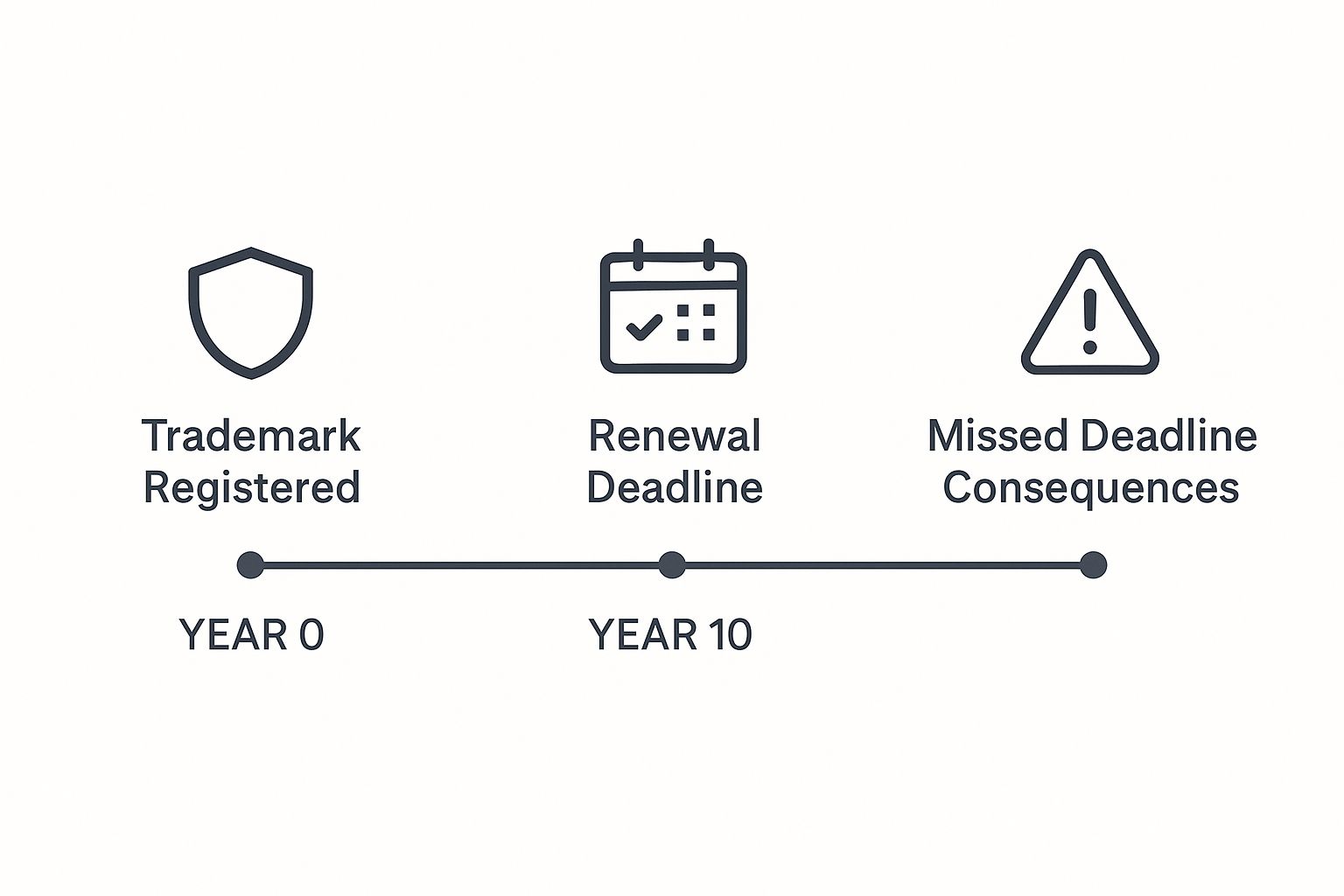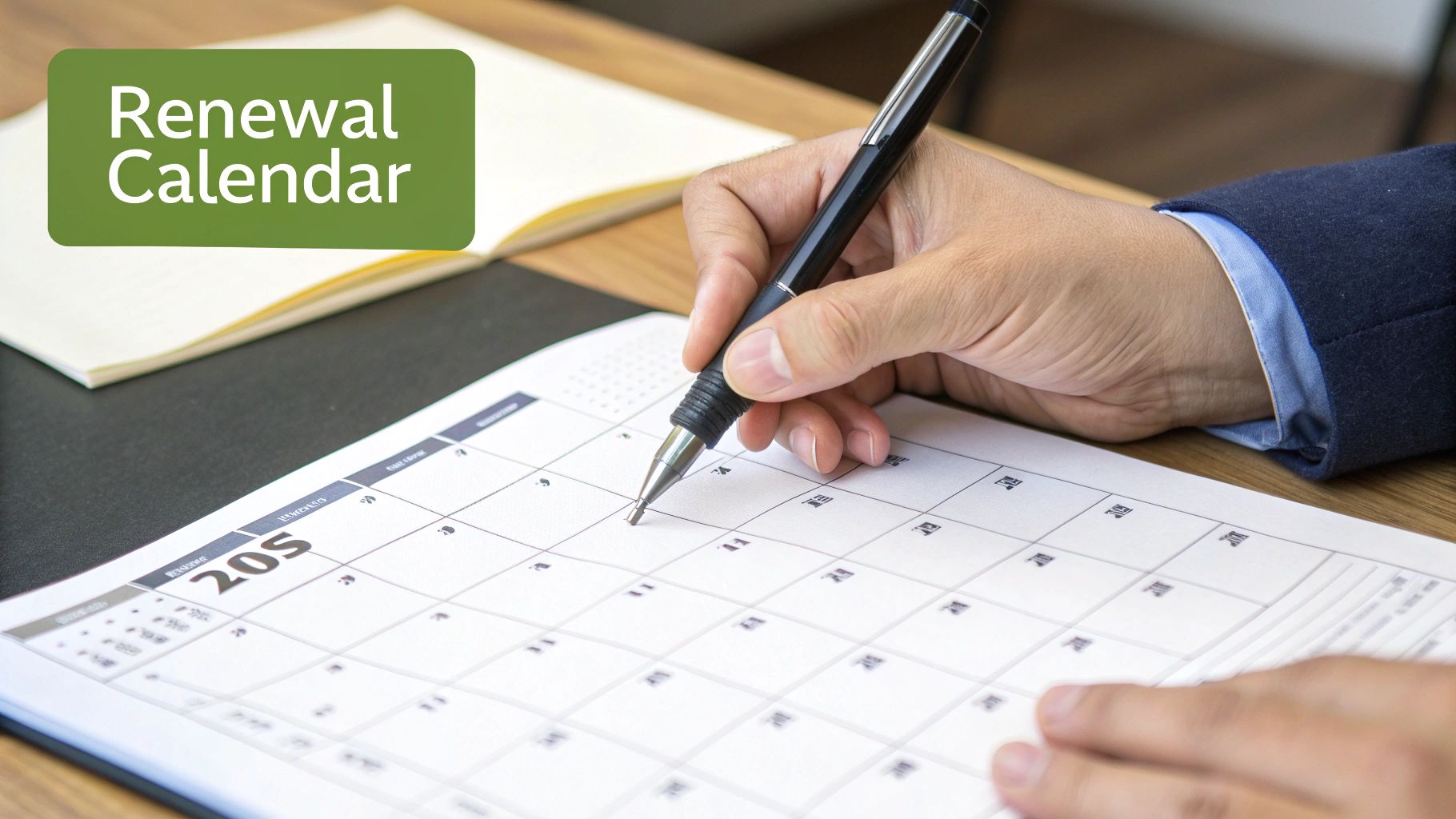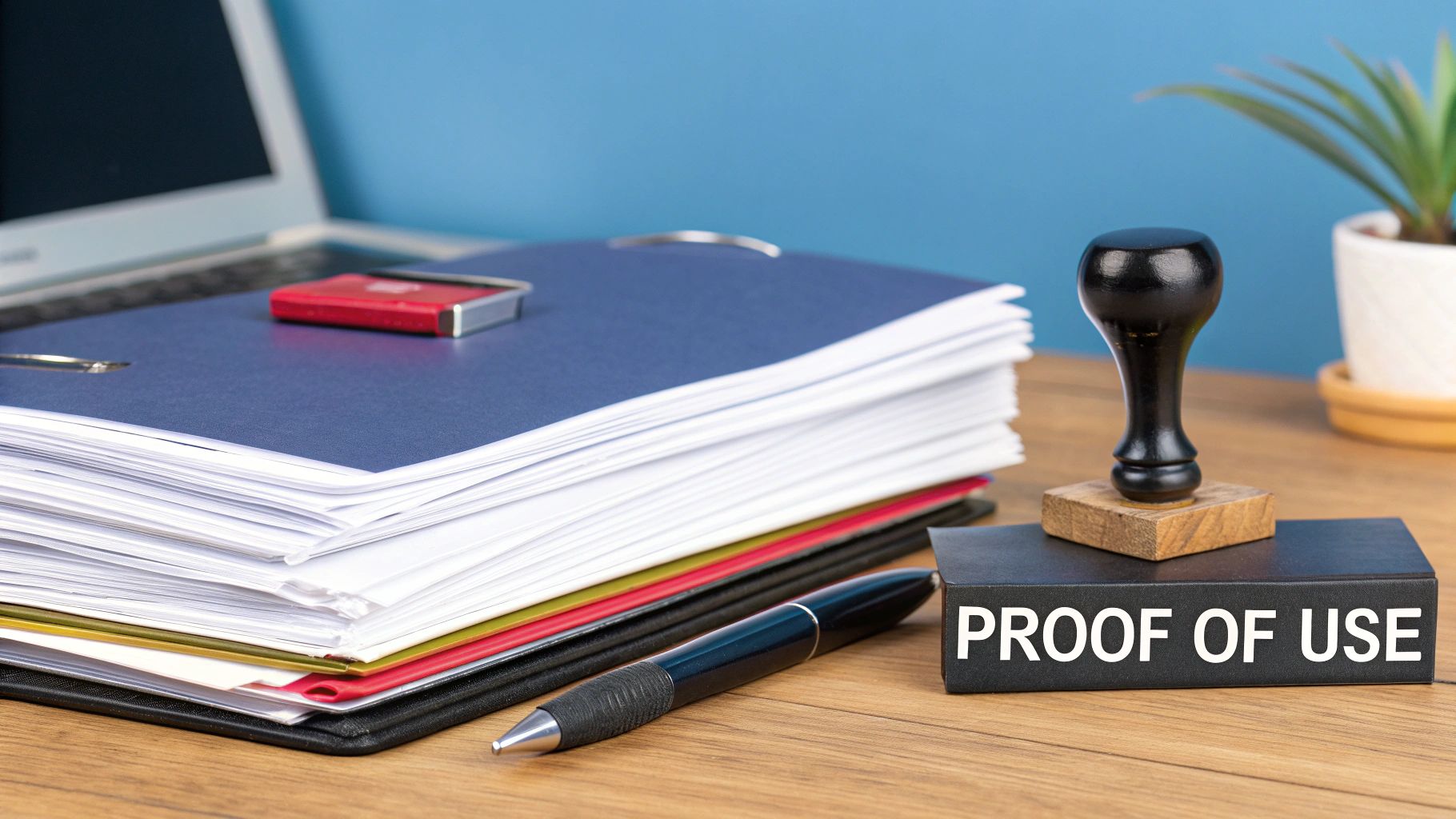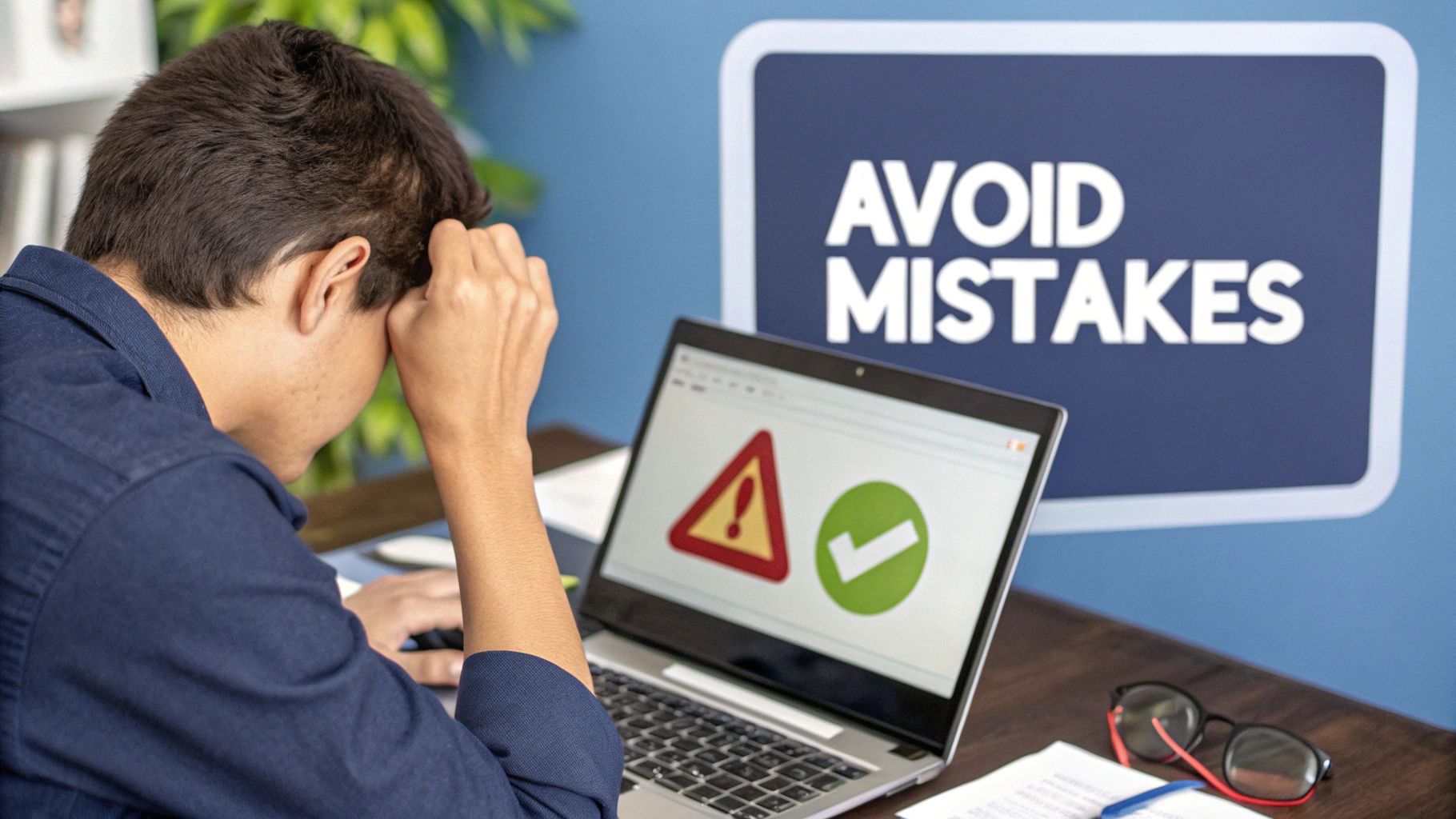Your trademark is more than just a slick logo or a catchy name. It's a serious business asset, and like any valuable asset, it needs regular upkeep to keep its legal protection intact. A renewal of trademark is the formal process of filing with the United States Patent and Trademark Office (USPTO) to keep your registration alive and kicking, ensuring your brand stays yours and only yours.
Why Your Trademark Renewal Is a Big Deal
Forgetting to renew your trademark can undo years of hard work in the blink of an eye. Seriously. One missed deadline could force you into a costly rebranding nightmare or nasty legal battles you never saw coming.
Think of your registration not as a one-and-done task, but as an ongoing promise to protect your brand鈥檚 reputation, the trust you鈥檝e built with customers, and your position in the market. Letting it lapse swings the door wide open for competitors to swoop in and legally use a similar name or logo. That creates market confusion and chips away at all the value you've built.
Renewing your trademark isn't just about checking a legal box. It's a strategic move that safeguards your business's very identity and its power for . Every single dollar you鈥檝e poured into marketing, packaging, and creating loyal customers is directly tied to that mark.
Protecting Your Investment
Picture this real-world scenario: a local coffee shop spends a decade building a beloved community brand, only to find out they missed their renewal deadline. A new chain could then legally set up shop down the street with a confusingly similar name, peeling away customers who think it鈥檚 the original spot. All that goodwill? Gone.
A trademark is an invaluable asset that, unlike other forms of intellectual property, can last forever as long as it is properly maintained and renewed. Failing to do so is like letting the deed to your house expire.
The timeline below maps out the critical points in a federal trademark's life, from the day it's registered to that first crucial renewal window.

As you can see, that ten-year checkpoint is a non-negotiable deadline for keeping your federal rights. The competition for brand recognition is fierce and getting fiercer. Consider that nearly 62% of global trademark filings are now packed into just five major intellectual property offices. That鈥檚 why a hands-on approach to how you manage intellectual property isn鈥檛 just smart鈥攊t鈥檚 essential for survival.
Navigating Critical USPTO Renewal Timelines

Missing a USPTO deadline isn't just a minor slip-up. It can permanently cancel your trademark registration, and trust me, the timelines are strict and unforgiving. The whole system is designed to make sure trademarks are actively being used in business, not just collecting dust in a filing cabinet.
Let's say you just successfully registered your brand today. You might think you can relax for a decade, but your first major deadline is actually much sooner.
Your First Check-In: The 5-Year Mark
Between the fifth and sixth years after your registration date, you have to file your first maintenance document. The official name is the Section 8 Declaration of Use or Excusable Nonuse.
Think of it as the USPTO's way of asking, "Hey, are you still actually using this mark for the stuff you said you would?" It's how they clear out "deadwood"鈥攖rademarks that were registered but never really used or were abandoned along the way.
To prove it, you'll need to submit a "specimen," which is just real-world proof that your mark is still out there in the marketplace.
This first filing is more than a formality; it's a progress report. It's your chance to prove your trademark is a living, breathing part of your business.
Settling In: The 10-Year Renewals
Once you clear that first hurdle, things settle into a more predictable rhythm. From that point on, you have to file for renewal every 10 years. These filings are a two-for-one deal, combining a couple of key documents:
- Section 8 Declaration of Use: Same as before, this confirms you're still using the mark in commerce.
- Section 9 Application for Renewal: This is the straightforward request to renew your registration for another 10-year term.
For example, if your trademark was registered on November 15, 2025, your renewal window would crack open on November 15, 2034, and slam shut on November 15, 2035. Miss that window, and your registration is in serious trouble.
To make it easier, here's a quick breakdown of the key deadlines.
USPTO Trademark Renewal Deadlines at a Glance
This table summarizes the main filing periods you'll need to track to keep your federal trademark registration active.
| Filing Window | Required USPTO Form | Purpose of Filing |
|---|---|---|
| Years 5-6 after Registration | Section 8 Declaration of Use | First confirmation that the trademark is still in active use. |
| Years 9-10 after Registration | Combined Sections 8 & 9 | Confirms continued use and formally requests a 10-year renewal. |
| Every 10 years thereafter | Combined Sections 8 & 9 | Ongoing confirmation of use and renewal for subsequent 10-year terms. |
Staying on top of this schedule is the single most important thing you can do to protect your brand long-term.
The Grace Period: A Costly Safety Net
So, what happens if you miss a deadline? The USPTO gives you a six-month grace period right after your renewal window closes. It might sound like a helpful cushion, but relying on it is a stressful and expensive mistake.
Filing during the grace period means paying a hefty surcharge on top of the normal renewal fees. More importantly, it pushes you right up against the absolute final cutoff. Once that six-month grace period is over, your registration is cancelled. No extensions, no second chances. If you find yourself in this situation, you can find more detail on how to file a USPTO trademark renewal under pressure.
The best approach? Be proactive. Don't wait for the deadline to sneak up on you. Set multiple calendar reminders for yourself at least a year before your renewal window even opens. This gives you plenty of time to gather your proof of use, budget for the fees, and file everything without the last-minute panic.
The Essential Paperwork for Your Renewal

Successfully renewing your trademark is about more than just checking a box and paying a fee. You have to prove to the USPTO that your trademark is still a living, breathing part of your business. This is where the core paperwork comes in: the Section 8 Declaration of Use.
This declaration is basically your sworn statement confirming your mark is still in "use in commerce." But what does that really mean? For the USPTO, it means you're actively selling goods or providing services with that mark across state lines or internationally. It鈥檚 not enough for your brand to just exist鈥攊t has to be out there, generating business.
To back up your claim, you'll need to submit a "specimen," which is just a real-world example of your mark in action. Think of it as the evidence that connects your original registration to what you're doing in the market today. The quality of that specimen can genuinely make or break your renewal.
Proving Your Use in Commerce
The kind of proof you'll need depends entirely on whether your trademark is for a product or a service. The USPTO has very different expectations for each, and sending in the wrong type is a classic, and totally avoidable, reason for rejection.
For goods or products, you need to show the mark directly on the item itself or its packaging. Put yourself in the customer's shoes鈥攈ow would they see your brand when they're about to buy something?
- Photos of product tags showing your logo.
- Pictures of the actual packaging where your brand name is clearly displayed.
- Screenshots of a point-of-sale display in a physical store.
When it comes to services, the focus shifts to materials that advertise or show the service being offered. Since you can't exactly "package" a service, the proof needs to link the mark directly to the service you're selling.
- Screenshots from your website where a customer can actually book or purchase your services.
- Marketing brochures or flyers that clearly advertise the services under your brand.
- A photo of your branded company vehicle, but only if it鈥檚 directly tied to the service (like a plumbing truck or a delivery van).
A quick heads-up: just having your logo on your website's homepage isn't enough. The specimen has to show a direct link between the mark and the sale of your services, like a "Buy Now" or "Schedule a Consultation" button right next to the service description.
What if Your Mark is Temporarily Benched?
So what happens if your business hits a temporary snag and you aren't actively using the mark when the renewal is due? Life happens. Maybe there are production issues, a business pivot, or other things outside your control that have put operations on pause. In these very specific situations, the USPTO lets you file a Declaration of Excusable Nonuse.
Now, this isn't a get-out-of-jail-free card. You must provide a legitimate, detailed, and compelling reason for the nonuse that is truly beyond your control. Simply deciding to take a break or running low on funds won't fly.
Acceptable reasons might include situations like:
- A fire or natural disaster destroyed your manufacturing plant.
- A trade embargo has temporarily cut off your supply chain.
- A serious illness forced a temporary shutdown of the business.
You'll need to clearly explain the circumstances and state when you realistically expect to start using the mark again. The USPTO looks at these claims very closely, so be ready to give an honest and persuasive explanation. Getting this paperwork in order ahead of time is the secret to a smooth trademark renewal.
Understanding the Costs of Trademark Renewal
Let's talk money. You absolutely have to budget for your trademark renewal鈥攊t鈥檚 a non-negotiable part of managing your intellectual property. The total cost isn't just one flat rate; it's a mix of government fees, potential penalties for being late, and whether you decide to bring in professional help.
The biggest chunk of your renewal bill will come directly from the . These government filing fees are calculated per class of goods or services in your registration. So, if your brand is registered in three different classes, you're going to pay that filing fee three times. Simple as that.
This is actually a great moment to take a hard look at your registration. Are you still actively selling products or offering services in all the classes you originally registered? If not, you can choose to delete a class, which will directly lower your renewal bill.
Breaking Down the Core Expenses
The number of classes you decide to keep is the biggest variable in your budget. Let鈥檚 walk through a simple, real-world scenario.
Imagine you own a clothing brand. Your trademark might be registered in:
- Class 025 for the actual clothing, like shirts and hats.
- Class 035 for the retail store services where you sell them.
When it's time to renew, you'll need to pay the USPTO's fee for both classes. That doubles your government cost right there. But what if you've since shut down your physical store to focus only on e-commerce? You could decide to drop Class 035 and save yourself some cash.
Procrastination comes with a literal price tag. If you file during the six-month grace period, the USPTO adds a significant surcharge per class on top of the standard fees. It鈥檚 a costly penalty for a delay you can easily avoid.
The Value of Professional Help
Beyond the government fees, you have a big decision to make: handle the renewal yourself or hire a professional. A DIY approach saves money upfront, but it puts all the responsibility squarely on your shoulders. You have to get the paperwork, the specimens, and the deadlines exactly right. One mistake can be disastrous.
Hiring a trademark attorney or a dedicated renewal service adds to the cost, but it provides a critical safety net. These pros manage the entire process for you, from tracking deadlines to making sure your evidence of use (those "specimens") meets the USPTO's strict standards. To get a better sense of what this might involve, you can explore typical attorney fees for small business and see how these services are usually structured.
More and more business owners are choosing this route. In fact, the global market for patent and trademark renewal services was valued at $11.29 billion in 2025 and is projected to keep growing. This trend is driven by an increasing number of entrepreneurs who understand the high stakes. You can to see why so many businesses are opting for expert guidance instead of risking their brand.
Common Renewal Mistakes and How to Avoid Them

The road to a successful trademark renewal is littered with potential landmines. A simple clerical error or misunderstanding the rules can have huge consequences, easily leading to a rejected application and, in the worst-case scenario, the total loss of your federal registration.
Trust me, it happens more than you'd think. The best way to navigate this process is to learn from the missteps others have made. By understanding where brand owners frequently go wrong, you can sidestep these issues and get your renewal through smoothly on the first try.
Submitting Unacceptable Proof of Use
One of the most common鈥攁nd damaging鈥攎istakes I see is submitting the wrong kind of "specimen," which is just the USPTO's term for proof of use. They have incredibly strict rules about what counts as evidence that your mark is actually being used in commerce. It鈥檚 not enough to just have a great brand; you have to show it in action, out in the wild.
Here are a few real-world examples of specimens that will get your application flagged for an office action almost instantly:
- Mockups and digital renderings: A business owner once sent in a beautifully designed mockup of their new product packaging. Problem was, it wasn't a photo of a real product being sold. It was rejected immediately.
- Internal documents: Company letterheads, invoices, and internal memos simply don't count. Why? Because your customers never see them during a purchasing decision.
- Advertising materials for products: This one trips people up all the time. For physical goods, a flyer or a website banner is considered advertising, not proof of use on the product itself. You need a photo of the product tag, the box it comes in, or the item itself with your mark clearly visible.
The golden rule for specimens is authenticity. Your proof must show the mark exactly as a customer would see it in the real world when they're about to make a purchase. Anything less will likely result in a costly delay or an outright rejection.
Mismanaging Multi-Class Registrations
Another headache I see a lot involves multi-class registrations. Many brands are registered across several classes of goods or services, and when it comes time to renew, you have to pay close attention to each one individually.
A frequent error is simply miscalculating the fees. You have to remember, the USPTO filing fee is per class. If your mark is registered in three classes, you must pay the full renewal fee three times. Forgetting this leads to an incomplete filing that can put your entire registration at risk.
Just as important is being honest about your use in each class. If you've stopped offering services in one of your registered classes, you must delete it from your renewal application. Claiming use for a class you've actually abandoned is considered fraud and can invalidate your entire trademark. Don't risk it.
Simply Missing the Final Deadline
This might sound obvious, but it happens constantly. Brand owners get busy, calendar reminders get dismissed, and renewal windows slam shut. The USPTO does not send you friendly reminders; the responsibility is 100% on the trademark owner.
Missing the final deadline, including the six-month grace period, is catastrophic. Your registration is canceled. Your federal protection vanishes overnight. To get it back, you have to start the entire application process from scratch, with absolutely no guarantee of success.
The growing complexity and high stakes are why many business owners now turn to professional help. The market for patent and trademark renewal services is booming, projected to hit nearly $6.87 billion globally by 2025. This 42.5% increase from 2021 shows that savvy entrepreneurs are investing in experts to avoid these costly鈥攁nd preventable鈥攅rrors. You can dig into more data about the .
A Few Common Trademark Renewal Questions
Even with the best guides, renewing a trademark can feel a bit nerve-wracking. The stakes are high, and the little details really do matter. We've pulled together some of the most common questions we get from brand owners to give you some quick, clear answers.
What Happens If I Miss the Renewal Deadline and Grace Period?
This is the big one, and the answer is blunt: if you miss both the one-year filing window and the six-month grace period that follows, the USPTO cancels your federal trademark registration. It's not just suspended鈥攊t's gone.
The second it鈥檚 canceled, you lose all federal protection for your brand name or logo. Period.
To get those rights back, you have to start over by filing a completely new trademark application. There鈥檚 absolutely no guarantee it will be approved the second time around, especially if a competitor swooped in and registered a similar mark while yours was unprotected.
Do I Have to Renew My Trademark in Every Class?
Nope, and you really shouldn't if you're not actually using the mark in every class you originally registered. A trademark renewal isn't just a formality; it requires you to prove you're actively using your mark for the specific goods or services listed.
For the renewal, you have to submit proof of use (a specimen) for each class you want to keep. If your business has pivoted鈥攕ay, you stopped selling branded t-shirts (Class 25) to focus only on your consulting work (Class 35)鈥攜ou can, and should, delete that unused class. This keeps your registration accurate and, as a bonus, lowers your USPTO renewal fees.
Think of the renewal process as a great time for a brand audit. Be honest about which parts of your business are still active and trim any classes that no longer fit. This actually strengthens your registration by focusing it on what you truly do.
Can I Change My Trademark During Renewal?
You can't make any major changes to your trademark when you renew. The whole point of a renewal is to maintain the existing registration just as it was first granted. The USPTO needs to see that the mark your customers recognize is the exact same one you have on file.
If you鈥檝e completely redesigned your logo or changed your brand name, you鈥檒l need to file a brand-new trademark application to protect that new version. Minor tweaks that don't change the overall impression of the mark might be okay, but this is a tricky area. Trying to sneak in an update through a renewal filing is a classic mistake that will get your filing rejected.
Is a State Renewal the Same as a Federal Renewal?
Not even close. They are two totally separate systems and you have to manage them independently.
A federal renewal with the USPTO maintains your protection across the entire country, following those strict 5- and 10-year timelines. A state trademark registration is only valid within that specific state's borders. Each state has its own schedule, its own fees, and its own rules. Forgetting to renew your USPTO registration because you remembered to renew your state one is a critical error that leaves your brand exposed everywhere else.
Navigating the complexities of trademark renewal can be daunting, but you don't have to do it alone. The team at Cordero Law specializes in intellectual property and is dedicated to protecting your brand's future. Contact us today for strategic counsel and personalized support.
